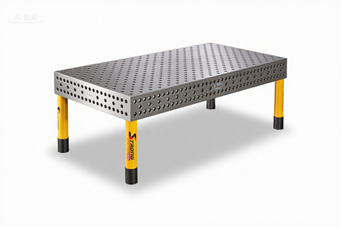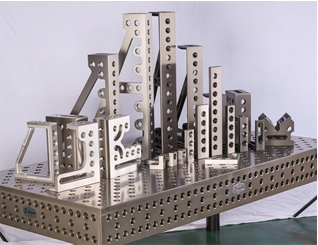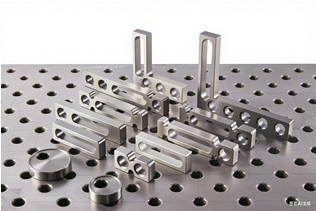— NEWS —
NEWS CENTRES Customer Service (86)21-65683273
Customer Service (86)21-65683273 E-mail:info@shwgec.com
Phone:(86)21-65683273
Add:No.38, Taiding Enterprise Park, Baoshan Urban Industrial Park, Shanghai, China
发布时间:2025-09-11 人气:42
Three-dimensional welding worktables and modular fixtures used in marine engineering, deep-sea operations, and ship pipelines typically require stainless steel material. This is determined by the specific service environment (deep-sea high pressure, high humidity, strong corrosion), welding process requirements (precision, cleanliness, structural stability), and long-term reliability needs. The analysis can be expanded from the following four key dimensions:
1. Resisting Extreme Corrosion: Meeting the Core Demand of Marine Engineering (Deep-Sea) "Wet Environments"
Long-term operation in seawater (or high-humidity cabin environments) exposes equipment to salt mist and condensation in the air. During welding, contact with cooling fluids and residual welding shielding gases may occur. ordinary steel (such as carbon steel) is highly susceptible to electrochemical corrosion or oxidative rusting. The corrosion resistance of stainless steel directly addresses this issue.
· Composition Level: The chromium (Cr) content in stainless steel forms a dense "chromium oxide passive film" on the surface (only a few nanometers thick). Even if the surface is slightly scratched, this film can quickly self-repair, preventing further corrosion penetration. Some models (e.g., 316L) also add molybdenum (Mo), further enhancing resistance to seawater and chloride ions, making them perfectly suited for marine environments.
· Practical Significance: If ordinary steel is used, the worktable may produce rust slag and oxide scale due to corrosion. These impurities can mix into pipeline welding joints (such as those in submarine ballast water pipelines or fuel pipelines), causing "slag inclusion" defects in the weld. In minor cases, this reduces weld strength; in severe cases, it can lead to pipeline leakage, potentially causing critical failures under deep-sea high pressure.

2. Ensuring Welding Precision: Meeting the "Stringent Tolerances" of Submarine Pipelines
The welding precision requirements for submarine pipelines (e.g., hydraulic pipelines, cooling pipelines) are extremely high. The straightness, flatness, and dimensional tolerances of welds directly affect the sealing performance of pipeline assemblies (under deep-sea high pressure, "a minute error can lead to a massive mistake"). Stainless steel worktables ensure precision during welding from two aspects: structural stability and surface characteristics.
·Low Deformation Rate, Long-Term Stability: The thermal expansion coefficient of stainless steel is similar to that of carbon steel, but its "thermal stability" at high temperatures is superior. During welding, localized high temperatures (arc temperatures can exceed 3000°C) can cause permanent deformation in ordinary steel (e.g., warping or denting of the workbench surface), leading to "benchmark deviation" during pipeline welding. Stainless steel offers higher high-temperature strength and resistance to deformation, maintaining the flatness of the worktable surface over the long term (typically ≤0.1mm/m), providing a stable reference for pipeline positioning.
· Smooth Surface, Reducing Impurity Interference: Stainless steel worktables can achieve low surface roughness (Ra ≤0.8μm) through polishing. Compared to the rough surface of ordinary steel (which easily accumulates dust and dirt), this prevents impurities (e.g., dust, rust) from adhering to pipeline joints during welding, reducing welding defects such as "porosity" and "lack of fusion." Submarine pipeline welds must pass strict tests like "X-ray inspection" and "hydrostatic testing," where any minor defect can lead to failure.


3. Enhancing Structural Durability: Withstanding High-Frequency Welding Workloads
Submarine pipeline welding is a "high-load, high-precision" operation. The mechanical properties of stainless steel ensure the long-term durability of the worktable.
·Balance of High Strength and Toughness: The tensile strength of stainless steel (e.g., 304 stainless steel, approximately 515MPa) is higher than that of ordinary mild steel (approximately 370MPa), and it exhibits excellent low-temperature toughness. This enables it to withstand impact loads during pipeline and flange lifting and flipping, preventing deformation and wear of the worktable.
·Wear Resistance and Easy Maintenance: During welding, sliding and friction may occur between the pipeline and the worktable surface. The surface hardness of stainless steel is higher than that of untreated ordinary steel, making it less prone to scratches. Additionally, the stainless steel surface is easy to clean (e.g., with high-pressure water or alcohol). Even if contaminated with welding spatter (molten metal particles), it can be easily removed by grinding, ensuring strong durability and a long service life.
4. Avoiding "Dissimilar Metal Contamination": Ensuring Pipeline Material Consistency
Submarine pipelines are often made of stainless steel (e.g., 316L, 904L). If ordinary steel worktables are used, "dissimilar metal contact contamination" may occur.
· Risk of Electrochemical Corrosion: When ordinary steel (carbon steel) comes into contact with stainless steel pipelines, the difference in electrode potential between the two metals (carbon steel has a lower potential, stainless steel has a higher potential) creates a "galvanic cell," accelerating the corrosion of carbon steel. This may also cause "galvanic corrosion" (localized rusting) in stainless steel pipelines, compromising pipeline integrity.
·Material Purity Requirements: The media transported through submarine pipelines may include fuel, hydraulic oil, or even nuclear reactor coolant (in nuclear submarines). If impurities from the worktable material (e.g., sulfur or phosphorus in carbon steel) transfer to the pipeline welding joint, the corrosion resistance and strength of the weld may be reduced. Stainless steel worktables, being of the same material origin as the pipelines (or belonging to the same category of corrosion-resistant alloys), completely avoid such contamination, ensuring the safety of media transport.
Conclusion: Stainless Steel Is the Optimal Solution for "Environment, Process, and Safety"
The material selection for submarine pipeline welding worktables is essentially driven by the dual demands of "extreme submarine operating conditions" and "welding process precision." Stainless steel's corrosion resistance addresses the "rusting in marine environments" issue, its low deformation ensures "welding precision," its high strength meets "long-term durability" needs, and its material homology avoids "contamination risks." Compared to materials like ordinary steel or cast iron, stainless steel may have a higher cost, but it fundamentally ensures the welding quality and long-term reliability of submarine pipelines, which directly impacts the navigation safety of submarines (e.g., preventing deep-sea pipeline leaks or structural failures).

Previous article::3D Module Welding Fixture
Next article::NO DATA
Pelevant Content